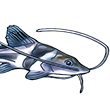| Scientific Name | Rineloricaria latirostris (Boulenger, 1900) |
| Common Name | Whiptail Catfish |
| Type Locality | Rio Mogi Guaçu, about 250 mi. inland of Santos, Brazil. |
| Synonym(s) | Loricaria latirostris, Loricaria paulina |
| Pronunciation | rhine lor ee kar ee ah. - lat ee ross triss |
| Etymology | Greek, rhinos = nose + Latin, lorica, loricare = cuirass of corslet of leather. |
| Size | 360mm or 14.2" SL. Find near, nearer or same sized spp. |
| Sexing | Males are larger, but more importantly, mature males are very `hairy`, covered with hairlike growth on their entire body and unlike most loricarinae that have these spines on the sides of the head, the pectoral fins and the top of the head; this particular fish can be covered in `hair` everywhere, except on the ventral surface. Females lack the `hair`. |
| Distribution | South America: Upper Paraná River basin. La Plata, Paraná, Upper Paraná, Grande (Paraná), Uberaba (click on these areas to find other species found there) La Plata, Paraná, Upper Paraná (click on these areas to find other species found there) La Plata, Paraná, Upper Paraná, Pardo (Mato Grosso do Sul), Mogi Guaçu (click on these areas to find other species found there) Login to view the map. |
| IUCN Red List Category | Least Concern , range map and more is available on the IUCN species page. Last assessed 2018. |
| Temperature | 18.0-22.0°C or 64.4-71.6°F (Show species within this range) |
| Other Parameters | This species doesn't tolerate higher temperatures well. |
| Feeding | An omnivore. Vegetables; peas, cucumber etc. invertebrates too; mosquito larvae, crustaceans (daphnia, gammarus etc), tropical flake and tabs. Sieves the sand for edible bits. Won't clean glass, plants or wood; it isn't much of an algae eater at all! User data. |
| Furniture | Something of a burrower, this species requires open space to move around on the floor, gravel, stones and sandy areas are mandatory. It sinks vertically into the sand by making wriggling sideways motions. It does not dive head first in the sand, like some other catfishes do. |
| Compatibility | Peaceful. It's a very slow, timid fish, so it is suspectible to food competitors. Small, docile fish; nothing too big ones or assertive. Neither should the substrate be crowded with many catfish or other fishes. It can get scared by larger bottom dwelling fishes, in which case it'll rapidly burrow itself and won't come up again for some time. |
| Breeding | Not reported. |
| Breeding Reports | There is no breeding report. |
| Reference | Annals and Magazine of Natural History (Series 7) v. 5 (no. 26) (art. 19), pp 165. |
| Registered Keepers | There is no registered keeper. |
| Wishlists | Love this species? Click the heart to add it to your wish list. There are 2 wishes to keep this species, see who wants what. |
| Spotters | Spotted this species somewhere? Click the binoculars! There are 3 records of this fish being seen, view them all. |
| Forum BBCode | |
| Search for R. latirostris | |
| Look up R. latirostris on AquaticRepublic.com | |
 | Look up R. latirostris on Fishbase |
 | Look up R. latirostris on Encyclopedia of Life |
 | Look up R. latirostris on Global Biodiversity Information Facility |
| LFS label creator ARN ref:1.4.43.814 | |
| Last Update | 2025 Jan 01 12:02 (species record created: 2002 Mar 07 00:00) |





/siluriformes/loricariidae/rineloricaria/latirostris/1.jpg)
/siluriformes/loricariidae/rineloricaria/latirostris/2.jpg)
/siluriformes/loricariidae/rineloricaria/latirostris/3.jpg)
/siluriformes/loricariidae/rineloricaria/latirostris/4.jpg)
/siluriformes/loricariidae/rineloricaria/latirostris/5.jpg)
/siluriformes/loricariidae/rineloricaria/latirostris/6.jpg)
/siluriformes/loricariidae/rineloricaria/latirostris/7.jpg)
/siluriformes/loricariidae/rineloricaria/latirostris/8.jpg)